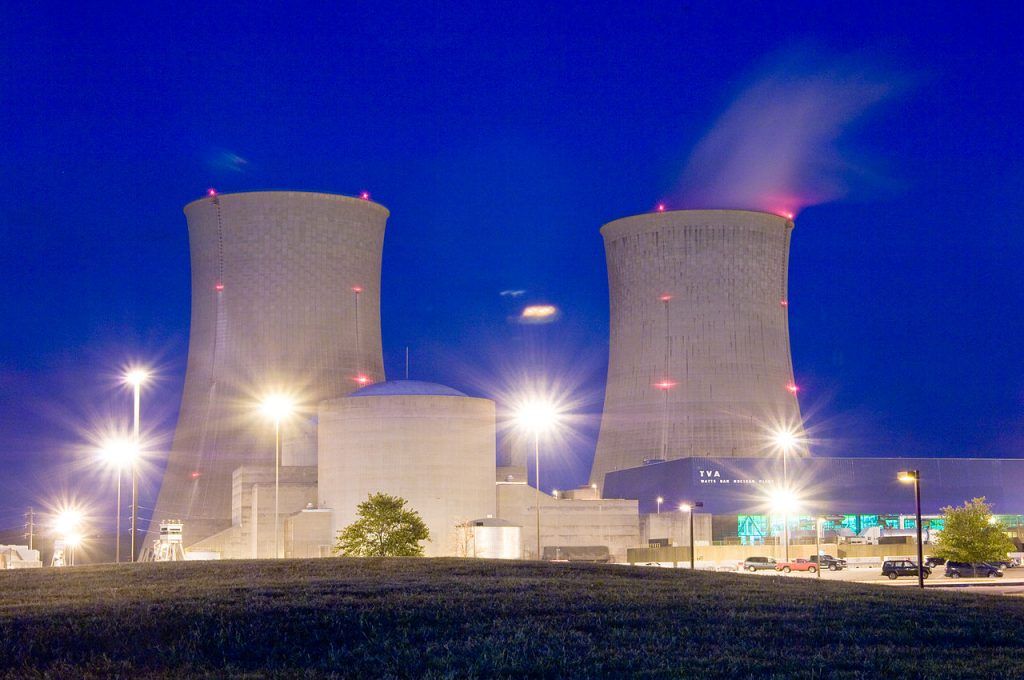Why nuclear power plants cost so much—and what can be done about it
By Daria Iurshina, Nikita Karpov, Marie Kirkegaard, Evgeny Semenov | June 20, 2019
 The Watts Bar Nuclear Power Plant Unit 2, located in Tennessee, took more than 40 years to complete.
The Watts Bar Nuclear Power Plant Unit 2, located in Tennessee, took more than 40 years to complete.
Despite a reduction in the rate of global nuclear energy deployment, nuclear power continues to be a promising solution to both the increasing demand for electricity and the increasing challenge of climate change. However, nuclear energy remains a capital-intensive technology, and not all countries can afford to use it. The global sustainability of nuclear power thus relies on efforts to increase its economic viability. But how?
Standardized designs and downsized reactors can help. Governments can offer additional support. But that still might not be enough to keep the nuclear power industry alive in the United States.
The high cost of nuclear power. The cost of nuclear power is often broken down into capital costs and operating costs. Capital costs include site preparation, engineering, manufacturing, construction, commissioning, and financing. Operating costs include fuel costs (from uranium mining to fuel fabrication), maintenance, decommissioning, and waste disposal. The capital costs of a nuclear power plant are much higher than for energy sources such as coal and natural gas—and the annual cost of repaying the initial investment is substantially higher than the annual operating costs. This is because nuclear power plants are technically complex and must satisfy strict licensing and design requirements. The design and construction of a new nuclear power plant requires many highly qualified specialists and often takes many years, compounding financing costs, which can become significant. Design changes or lawsuits can cause delays that further increase the financing charges, which in some cases exceed the actual construction costs.
The high cost of constructing plants has made it difficult for nuclear power to compete with other energy options in the United States, particularly natural gas. The high cost of nuclear power has led to a significant decline in the construction of new plants—with just one plant, Watts Bar 2, entering commercial operation in the past 20 years.
In 2017, two South Carolina utilities abandoned two unfinished Westinghouse AP1000 reactors due to difficulties in equipment manufacturing, significant construction delays, and cost overruns—leaving just two other AP1000 reactors under construction, in the state of Georgia. These reactors have also faced delays and cost overruns. The original cost estimate of $14 billion has risen to $23 billion, but construction is proceeding, given the promise of government financial support for these reactors—the first of their kind in the United States.
One of the main reasons why nuclear power struggles in the United States is its high discount rate—a piece of the calculation of overall energy cost that reflects the capital costs of a project. Because of its high construction costs, nuclear power is more handicapped than natural gas or coal-fired plants by the discount rate.
The discount rate for nuclear construction projects in the United States is generally about 12.5 percent, higher than in many other countries, especially those where the nuclear industry is at least partially subsidized by the government. For example, discount rates for plant construction are typically closer to 8 percent in France and just 2–3 percent in Japan. This variation in discount rate is one of the major factors determining the economic viability of nuclear power across the world. A 2015 study of 22 countries found that, at a discount rate of 10 percent, the median cost of both natural gas and coal was lower than nuclear energy, while at a discount rate of 3 percent, nuclear energy was the most economical option in all countries analyzed.
Government-subsidized capital costs help explain the relative vitality of the nuclear power industry in Russia and China compared with the United States. In addition to six reactors under construction in Russia, the state-owned nuclear power company Rosatom’s current foreign portfolio includes 36 nuclear reactors planned or under construction. By 2030, the projects portfolio of Rosatom is expected to swell to 80 nuclear power plants, according to data on the official website of the company. Nevertheless, the future of nuclear energy in Russia will depend on how well Rosatom manages current nuclear projects, especially whether the deadlines and the contractual construction costs will be met.
Nuclear power is also expanding significantly in China. By 2026, China is expected to generate close to 100 gigawatts of electricity from nuclear energy, nearly tripling current production. In additional to lower capital and labor costs, large-scale standardization efforts and growing technical expertise in manufacturing and construction have helped make nuclear power economical in China.
Increased standardization, reduced size. While Russia and China have managed to increase nuclear power output in recent years, high costs are still constraining the growth that will be required to combat climate change while meeting increased electricity demands. Because the capital costs of nuclear power are so significant, the most effective way to reduce the total price of nuclear energy is to design and construct plants more efficiently. Historically, especially in the United States, new nuclear plants varied significantly in design, due to the continual incorporation of new technological advancements—and also because of differences in location, layout, climate conditions, and cooling methods. Several tens of electric utilities, nuclear equipment vendors, and engineering companies were involved in US nuclear plant construction and thus very little standardization was achieved. Contrast this with the situation in France, which had one national electric utility, one equipment manufacturer, and essentially one supporting engineering corporation.
The global trend is now moving toward more standardized designs. Standardization reduces design and construction uncertainties, as well as the time required to build future reactors, thus reducing capital costs. Capital costs can also be reduced by manufacturing more reactor components at the factory or shipyard, rather than constructing them on site. Manufacturing components and systems in controlled conditions allows for improved quality control, improved productivity of the work force, and altogether lower manufacturing costs. On the other hand, on-site construction requires training a local labor force, resulting in lower construction productivity and higher costs.
Small modular reactors might be especially well suited to off-site construction. Because of their small size and relative design simplicity, it is feasible to build modules primarily in a factory setting and then transport the completed modules to the plant site for installation. This would significantly improve construction efficiency and reduce capital costs.
The strict safety regulations imposed on the nuclear industry are another reason why capital costs are so high. Since the 2011 Fukushima accident in Japan, the public has become even more critical regarding the safety of nuclear power. Additional passive-control systems and security systems for emergency situations have further increased capital costs. While safety cannot be compromised, it is worth considering ways to reduce the economic burden of these regulations.
In recent years, many nuclear power experts have called for small modular reactors that do not require the same level of active safety systems and strict regulations as previous generations of reactors, given their more simplified designs and passive safety measures. These simplified reactors are also expected to have lower operating and maintenance costs. Due to the higher surface-to-volume ratio for these reactors compared with traditional reactors, many safety provisions for heat removal are unnecessary. (Another branch of nuclear power development is aimed at obtaining safer nuclear fuel, dubbed Accident Tolerant Fuel.)
While the capital costs of a nuclear power plant (typically about 60 percent of the total cost) outweigh its operating costs, reductions in operating costs should also be pursued so as to reduce the overall cost of nuclear power. This can be done by increasing operational efficiency. For example, some advanced reactor designs have higher power density and/or capacity factors (less down time) to increase power output, while requiring a smaller number of operators to attend to the reactor.
Advances in modeling can also help, by determining optimal reactor parameters. The global trend is to monitor power plants by developing models of the facilities. This method of design and operation is called BIM, short for Building Information Model. BIM collects and processes all architectural, design, technological, economic, and other information about the nuclear power plant and all its interconnections and dependencies. In other words, BIM creates a digital clone of the plant, which makes it possible to monitor the state of the plant, model the processes happening there, and conduct research—all of which can increase construction and operational efficiency.
The benefits of nuclear power. Up to this point, we have considered only the direct monetary cost of building and operating nuclear power plants. However, nuclear energy offers several less-quantitative benefits that could be considered in a broader economic analysis. Considering some of these “hidden profits” as part of an economic analysis can change the cost-benefit ratio. One benefit is that, unlike coal and natural gas, nuclear power plants do not emit significant quantities of greenhouse gases. This environmental benefit can directly affect nuclear power economics in areas where carbon credits or taxes have been implemented or are being considered.
The Clean Power Plan, introduced by President Obama in 2015, incentivized states to invest in low-carbon energy sources, including nuclear power, as a way to meet emissions-reduction targets. While repeal of the plan has begun under President Trump, future efforts to set stricter emissions limits could help make nuclear energy more economical than fossil fuels. Future policies might also reward nuclear plants for their contributions to grid stability.
In addition, a robust nuclear power industry can have national security benefits. In the United States, there is a general understanding that dominance in the nuclear arena has allowed the United States to set nuclear safety and security standards around the globe. Many US national security experts have warned about the effect of ceding authority on these issues to other countries with a different security perspective and economics/security calculus. These considerations argue for government actions to strengthen an industry that supports the government’s safety and security policies.
Russia has likewise viewed the export of nuclear reactors as a geopolitical, as well as economic, investment. Rosatom is expanding exports by offering attractive financing and a build-own-operate model that is especially appealing to nuclear newcomers who might not otherwise accept the financial risk of developing nuclear power on their own.
While nuclear power is an economical option in many countries, significant upfront capital costs are a barrier. Some advanced reactors have promising projected cost reductions, but these reactors are still in the design and prototype stage and may not be ready in time to address global climate change. In the short term, nuclear growth is possible in the countries where it is most economical—most notably China, Russia, India, and developing countries that can take advantage of Russia’s expansive build-own-operate model. In contrast, new traditional nuclear power plants are unlikely to be built in the United States unless external benefits are accounted for and incorporated in the actual plant costs.
Together, we make the world safer.
The Bulletin elevates expert voices above the noise. But as an independent nonprofit organization, our operations depend on the support of readers like you. Help us continue to deliver quality journalism that holds leaders accountable. Your support of our work at any level is important. In return, we promise our coverage will be understandable, influential, vigilant, solution-oriented, and fair-minded. Together we can make a difference.
Topics: Analysis, Climate Change, Nuclear Energy, Voices of Tomorrow



















This article glosses over the cost of dealing with radioactive wastes – they’re mentioned ever so briefly! Bloomberg covered this recently – “Americans Are Paying More Than Ever to Store Deadly Nuclear Waste as Plants Shut Down” https://www.bloomberg.com/news/articles/2019-06-14/u-s-bill-to-store-nuke-waste-poised-to-balloon-to-35-5-billion The claim that nuclear power combats climate change is ludicrous. Thousands of big nuclear stations, millions of small ones, would have to go up pretty much immediately,: they would be too late to have any effect on global warming. And that’s if they even were effective. In fact, the total nuclear fuel chain increases global warming. Nuclear power is clearly not economic… Read more »
Although you have quite a few points, your claim that “nuclear power combats climate change is ludicrous” and “the total nuclear fuel chain increases global warming” are, at best, misleading. As you will know, nuclear power does not emit CO2 directly. It does indirectly, yes, just as any other source (that includes solar, wind, hydro…). Results vary wildly depending upon assumptions and authors’ bias, but the scientific consensus is that both nuclear and renewables emit far less CO2 than fossil fuels. https://en.wikipedia.org/wiki/Life-cycle_greenhouse-gas_emissions_of_energy_sources In short, you seem to have fallen into the “special pleading fallacy” (denouncing the nuclear emissions and hiding… Read more »
WASHINGTON — The estimated cost of cleaning up America’s nuclear waste has jumped more than $100 billion in just one year, according to a DOE report — and a watchdog warns the cost may climb still higher. The Energy Department’s projected cost for cleanup jumped from $383.78 billion in 2017 to $493.96 billion in a financial report issued in December 2018. A government watchdog and DOE expert said the new total may still underestimate the full cost of cleanup, which is expected to last another 50 years. “We believe the number is growing and we believe the number is understated,”… Read more »
Your article also failed to consider the high ongoing cost of securing a nuclear power plant from terrorist attacks and the high cost that would be paid if one were to succeed. Nuclear power is simply not a smart choice economically no matter how you try to justify it. Further advances in battery storage and solar panel efficiency will be the final nails in the coffin for nuclear power. Note that if this fact was universally recognized and the use of nuclear power was halted worldwide, a significant side benefit would be that no country (Iran, for instance) could claim… Read more »